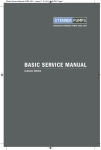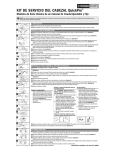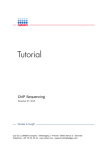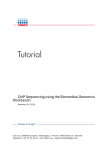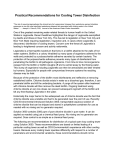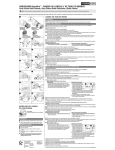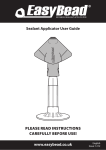Download Stenner® Basic Service Manual
Transcript
Basic Service Manual Classic Series Basic Service Manual Classic Series SECTION I – General Information Safety Precautions/Icons . . . . . . . . . . . . . . . . . . . . . . . . . . . . . . . . . . . 2 Tool List & Cleaning Supplies . . . . . . . . . . . . . . . . . . . . . . . . . . . . . . . . 3 Part Identification . . . . . . . . . . . . . . . . . . . . . . . . . . . . . . . . . . . . . . . . . . 4 SECTION II – Installation Review Proper Installation . . . . . . . . . . . . . . . . . . . . . . . . . . . . . . . . . . . 5 Spill Recovery . . . . . . . . . . . . . . . . . . . . . . . . . . . . . . . . . . . . . . . . . . . . . . 6 Vertical Wall Installation . . . . . . . . . . . . . . . . . . . . . . . . . . . . . . . . . . . . 6 Suction Line, Compression Seal . . . . . . . . . . . . . . . . . . . . . . . . . . . . . . 7 Rain Roof . . . . . . . . . . . . . . . . . . . . . . . . . . . . . . . . . . . . . . . . . . . . . . . . . 8 SECTION III – Separating & Reconnecting Subassemblies Rivet and Slot Identification . . . . . . . . . . . . . . . . . . . . . . . . . . . . . . . . . 9 Separating Subassemblies . . . . . . . . . . . . . . . . . . . . . . . . . . . . . . . . . 10 Reconnecting Feed Rate to Motor . . . . . . . . . . . . . . . . . . . . . . . . . . . . 11 Reconnecting Pump Head to Feed Rate . . . . . . . . . . . . . . . . . . . . . . . 12 SECTION IV – Maintenance Basics – Tube Tube – How It Works . . . . . . . . . . . . . . . . . . . . . . . . . . . . . . . . . . . . . . . 13 Tube Failure – Definition . . . . . . . . . . . . . . . . . . . . . . . . . . . . . . . . . . . . 14 Tube Fundamentals . . . . . . . . . . . . . . . . . . . . . . . . . . . . . . . . . . . . . . . . 15 Tube Failure – Causes & Corrective Action . . . . . . . . . . . . . . . . . 16-22 Tube Replacement & Centering . . . . . . . . . . . . . . . . . . . . . . . . . . 23-29 SECTION V – Maintenance Basics – Feed Rate Control (FRC) Feed Rate Control – How It Works . . . . . . . . . . . . . . . . . . . . . . . . . . . 30 Feed Rate Wear – Definition & Causes . . . . . . . . . . . . . . . . . . . . 31-32 Feed Rate Parts Replacement . . . . . . . . . . . . . . . . . . . . . . . . . . . 33-36 SECTION VI – Maintenance Basics – Motor Gear Case – How It Works . . . . . . . . . . . . . . . . . . . . . . . . . . . . . . . . . 37 Gear Case Wear – Definition . . . . . . . . . . . . . . . . . . . . . . . . . . . . . . . 38 Gear Case Parts Replacement . . . . . . . . . . . . . . . . . . . . . . . . . . . . . 38 Motor – How It Works . . . . . . . . . . . . . . . . . . . . . . . . . . . . . . . . . . . . . 39 Motor Failure – Definition & Causes . . . . . . . . . . . . . . . . . . . . . . . . . 39 Coil Replacement . . . . . . . . . . . . . . . . . . . . . . . . . . . . . . . . . . . . . . 40-43 Rotor Assembly Replacement . . . . . . . . . . . . . . . . . . . . . . . . . . . . . . 44 SECTION VII Quick Tips . . . . . . . . . . . . . . . . . . . . . . . . . . . . . . . . . . . . . . . . . . . . . . . . . . . . 45 INTRODUCTION The Stenner Classic Series peristaltic metering pumps are mechanical and will, during their service life, require scheduled maintenance. The purpose of this manual is to identify the five wear parts (pump tube, roller assembly, lifter, cam, and index plate) that will eventually require replacement, along with other maintenance basics. Best practice tips, such as a spill recovery to eliminate chemical leakage, as well as corrective actions are covered. 2 Section I General Information Safety Precautions NOTICE: Before installing or servicing the pump, read the pump manual for all safety information and equipment instructions. The pump is designed for installation and service by properly trained personnel. Hazardous Pressure/Chemical Exposure To reduce risk of chemical exposure, the use of proper personal protective equipment is mandatory when working on or near chemical metering pumps. Shut off water source. Use caution and bleed off all resident system pressure prior to attempting service or installation. Use caution when disconnecting discharge tubing from pump. Discharge tubing may be under pressure and may contain chemical. Important icons used in this manual BEST PRACTICE Factory recommended NOTE Additional information IMPORTANT! Key for optimum performance 3 Tool List & Cleaning Supplies • #2 Phillips head screwdriver • Flat blade screwdriver • 3/8" open end wrench (to change index pin lifter) • Stenner grease (AquaShield®) • Fantastik® or similar (non-citrus) all purpose cleaner • Needle-nose pliers • Utility knife 4 General Information Part Identification Stenner Classic Series Chemical Feed Pump Three Basic Subassemblies NOTE Additional information Use subassemblies in field for quick replacement. Repair and refurbish parts at shop. Section II Installation 5 Review Proper Installation 0-25 psi 26-100 psi 6 Installation Spill Recovery In case of tube rupture, chemical drains back into solution tank, reduces or limits spillage on the ground or floor and prevents chemical from collecting in tube housing. Vertical Wall Installation This type of installation is recommended by factory to keep chemical away from pump parts. 7 Suction Line Suction line should be 3" from tank bottom to prevent picking up sediment, which can cause blockage in the check valve duckbill and discharge line. Allow slack in suction/discharge tubing so pump tube fittings can flex. This prevents stress on tubing and tube fittings, reducing the chance for breakage and leaks. Compression Seal (ferrules) Beveled ends of ferrules face tube fittings. Tubing should bottom into all fittings NOTE Additional information For 3/8" connections only. While stabilizing the tube fitting, attach female end of adapter to the tube fitting(s) (ferrule inside). Slide line through 3/8" connecting nut and finger tighten to male end of adapter. If leak occurs, gradually tighten the 3/8" connecting nut as required. 8 Installation Rain Roof Recommended in all outdoor or wet environments. Pump motor is ventilated, and water intrusion can cause motor damage. Section III Separating & Reconnecting Subassemblies Rivet and Slot Identification 9 10 Separating & Reconnecting Subassemblies Separating Subassemblies 1. Turn the pump off and unplug the power cord. 2. Hold the feed rate control section and turn the pump head clockwise until it stops. 3. Pull the pump head straight out. 4. Hold the motor assembly, grasp the feed rate control section and turn clockwise until it stops, and pull it straight out. 11 Reconnecting Feed Rate to Motor 1. Before reconnecting the feed rate control to the motor, confirm pressure spring is in place and place feed rate control on the shaft. 2. Turn the feed rate control counterclockwise to line up the flat side of the motor shaft (d shaft) with the flat side of the spider (in the feed rate control) and push straight on. 3. Push and turn the feed rate control until the rivets (on the gear case) are inside the rivet holes on the feed rate. 4. Turn counterclockwise until it locks into place and the “bump” on the feed rate mounting plate fits into the indentation in the gear case cover. NOTE Additional information The arrow on the feed rate control should be on top and confirm the bump is in the indentation. 12 Separating & Reconnecting Subassemblies Reconnecting Pump Head to Feed Rate 1. Put the pump head (with main shaft) into the feed rate control and turn it counterclockwise until the shaft falls into place. 2. Push the pump head (toward the feed rate), while turning it counterclockwise, to line up the rivet holes on the pump head with the rivets on the feed rate control. 3. Continue to push until the rivets are inside the holes and the snap lock engages. 4. Turn the pump head counterclockwise to secure the rivets in the rivet slots, firmly attaching the pump head. Section IV Maintenance Basics – Tube TUBE (wear part) How it works The tube is squeezed by two of the three rollers that move along the tube. As the roller moves, the compressed section generates a vacuum, creating a self-priming function. The remaining two rollers repeat the process and the rotation creates a pumping action. 13 14 Maintenance Basics – Tube Tube Failure Definition The general cause of most tube failures is a lack of routine maintenance. A tube failure is indicated by a leak or a lack of output. A diamond pattern (where the tube presses against the pump head housing) indicates excessive back pressure, which could be caused by calcium blockage, clogged duckbill, or system pressure in excess of pump tube rating. An oval pattern indicates worn rollers and/or the tube reaching the end of its service life. Tubes can rupture without either pattern apparent. Tube Roller The tube can rupture or break. A rupture normally occurs at the point between the discharge tube fitting and the area where the roller leaves the tube. A break or rip occurs just past the suction fitting. The tube is the workhorse of the pump. It is perishable and eventually has to be changed. 15 Tube Fundamentals For maximum tube life Determine cause of tube failure before installing new tube • Natural wear, end of service life. • Blockage, excessive pressure, worn/damaged parts: identify and correct problem. IMPORTANT! Key for optimum performance Remember to check tube psi rating against application psi. Tube sizes 1, 2, 3, 4, 5 & 7 are rated from 0-25 psi; 1, 2 & 7 are rated from 26-100 psi when used with the injection check valve. Continued... 16 Maintenance Basics – Tube Tube Failures Causes and Corrective Action Excessive back pressure at the point of injection Blockage or restriction located inside the injection fitting portion of the check valve due to calcification or mineral deposits. Corrective Action 1. Insert a round shank screwdriver through injection fitting into the pipe to locate or break up accumulated deposits. If screwdriver can’t be inserted, drill the deposit out of the injection fitting. 2. Replace duckbill. BEST PRACTICE Factory recommended Replace duckbill with every tube change. 17 Excessive back pressure at the point of injection Blockage or restriction of the (check valve) duckbill due to insoluble sediments or particulates from the bottom of the tank. Corrective Action 1. Replace suction/discharge tubing and clean sediment from tank bottom. 2. Position suction weight 3" from tank bottom. 3. Use strainer. 4. Replace duckbill if necessary. Split along tube side Rubbing along roller assembly and pump head housing edge. Corrective Action 1. Center tube at time of new tube installation. NOTE Additional information Tube will not center if wrist twists during installation or if rollers are worn. Continued... 18 Maintenance Basics – Tube Frozen rollers in roller assembly Chemical intrusion. A cracked pump head housing Wear, chemical exposure, or incompatibility. Corrective Action 1. Pump head housing and roller assembly must be rinsed and wiped free of chemical residue or replaced if corroded or cracked. Rollers need to turn freely but without rocking/tilting from side to side. 2. Replace roller assembly and/or cracked housing. NOTE Additional information Normal roller wear can cause a lack of output as a result of the rollers’ inability to fully squeeze the tube. The wear is generally in the bore of the roller. To check for roller bore wear, hold each roller (at the top and bottom) between your thumb and index finger. If it rocks back and forth, replace the roller assembly. 19 BEST PRACTICE Factory recommended Mount pump vertically and use spill recovery to drain chemical back to tank in the event of tube failure. This will help prevent chemical from collecting in the tube housing and reduces spillage on the floor. Vertical Mount Spill Recovery NOTE Additional information Screws are self-tapping; back off screws to find original threads. If screw bosses are stripped, use screws to cut new threads in unused bosses. Position them opposite one another. The pump housing must flex to avoid pump head cracking. Do not use more than two screws. Continued... 20 Maintenance Basics – Tube Tube leaks around the fitting can result from: • Using pliers which can break internal seals and twist the tube. • Turning the fitting inside the tube when centering a replacement tube or when connecting suction/discharge lines. • Using thread sealant tape which prevents ferrules from seating into tube fitting. • Stress on tube fitting from a tight radius in the suction/discharge tubing. • Crushed ferrules from over tightening or use of pliers. Corrective Action 1. Finger tighten connecting nut. DO NOT use pliers. DO NOT use thread sealant tape. Hold tube fitting when tightening connecting nut to prevent fitting from turning. 2. Change ferrules with every tube change. Ferrules make the seal between tube fitting and the connecting nut. 21 Tube fittings pulling out of the tube can result from: • Pulling excessively on the tube fitting when installing a replacement tube. Allow rollers to stretch tube into position and follow tube replacement instructions. • Pre-stretching the tube before replacement. NOTE Additional information Due to wear, the used tube will have stretched and will be longer than the new tube. Normal tube failures • Pin hole at discharge side; tube will leak. • Breakage at the suction side. • Fatigued, no longer completely compresses, no rupture evident, doesn’t pump. The above conditions are usually indications that the tube has reached the end of its service life. If all other conditions/wear have been checked and corrected, determine maintenance schedule. NOTE Additional information Tube fitting flange cracks are normal on the discharge tube fitting. They DO NOT indicate a failure or defect. Continued... 22 Maintenance Basics – Tube Other tube failures • Using pump components not provided by Stenner can cause pump to malfunction. • Chemical incompatibility: petroleum and oil-based products not compatible with Santoprene® tube material. • Storage of tubes in high ambient temperatures and longterm exposure from direct sunlight. • Overpressure due to crushed/over tightened duckbill. Corrective Action 1. Use only Stenner accessories with Stenner pumps. 2. Check the chemical resistance chart for chemical compatibility or call the factory. 3. DO NOT store tubes in pump rooms or in direct sunlight. 4. DO NOT lubricate the pump tube or roller assembly. Points to Be Greased BEST PRACTICE Factory recommended Every time pump is serviced or a tube is replaced, apply grease (AquaShield®) to the pump head cover bushing and main shaft ONLY. 23 Tube Replacement and Centering BEST PRACTICE Factory recommended Prior to tube removal, pump water through tube to remove chemical. Removing the Old Pump Tube 1. Turn pump off. 2. Remove screws and then the cover by lifting the side opposite the tube fittings. 3. Set the feed rate dial on a low setting and leave on this setting until finished. 4. Turn the pump on and let it run until one of the three slots in the roller assembly lines up with the bottom tube fitting (suction side). Continued... 24 Maintenance Basics – Tube 5. Turn pump off. 6. Without moving the roller assembly further, lift the tube fitting out of the housing slot and pull it toward the center of the roller. 7. Turn pump on and allow roller assembly to jog while guiding the tube with tension up and out of the housing. 8. Turn the pump off. Completely remove the tube assembly. 25 After Removing Old Tube IMPORTANT! Key for optimum performance Identify the cause of tube failure prior to installing a new tube. 1. Remove roller assembly, shaft, and housing. 2. Use Fantastik® or similar (non-citrus) all purpose cleaner to clean all chemical residue from pump head housing, roller assembly, and cover. 3. Check housing for cracks and replace if cracked. 4. Ensure rollers turn freely. 5. Check rollers for excessive side play from bore wear. Replace roller assembly if worn. Continued... 26 Maintenance Basics – Tube 6. Inspect the suction/discharge tubing, point of injection, and check valve duckbill for blockages. Clean and/or replace as required. 7. Install clean housing. 8. Install and grease shaft. 9. Install roller assembly. Installing the New Pump Tube IMPORTANT! Key for optimum performance DO NOT lubricate pump tube or roller assembly. 1. Manually turn roller assembly (counterclockwise) to line up its slot with the tube housing slot. 2. Place the tube fitting into the housing and roller assembly slot. 3. Turn dial ring to L setting. • While holding the threaded tube fitting, turn the pump on and allow it to jog the roller assembly. • Guide the tube with slight tension (toward the center) to prevent pinching between the housing and roller assembly. 27 IMPORTANT! Key for optimum performance Avoid rotating wrist, which can result in a twisted tube that will not center. DO NOT force the tube and be careful of your fingers. 4. When the tube reaches the top housing slot, turn pump off. • Turn dial ring to 10, hold tube fitting firmly, and turn pump on. • Allow rollers to stretch tube into place while guiding the tube into the slot. 5. Turn the pump off. NOTE Additional information A used tube will stretch approximately 3/4 of an inch over its life. The new tube will appear to be stiff and short. Follow directions to allow rollers to stretch tube into place. Continued... 28 Maintenance Basics – Tube 6. Grease (AquaShield®) the cover bushing ONLY and replace the cover and the screws, leaving the front screw inbetween the fittings loose enough to rotate the tube fitting, in order to center tube on rollers. NOTE Additional information If pump head housing screws are stripped, use alternate bosses and position them opposite each other. Use only two at a time. Centering the Pump Tube 1. To center the pump tube on the rollers, set the Feed Rate dial to a setting of 10. Turn pump on. 2. Turn the IN (suction) tube fitting located on the bottom of the pump head not more than 1/8 of a turn in the direction the tube must move. 3. DO NOT let go of fitting until the tube rides approximately in the center of the rollers. 29 4. Turn the pump off, let go of fitting, and tighten the cover screws. The cover is not on securely if there is a gap between the screw boss and the cover. BEST PRACTICE Factory recommended Trim 1" off suction/discharge tubing before installing ferrules. Replace ferrules with every tube change. Fixed Rate Pump Tube Change To install a new tube in a fixed rate pump, utilize the on/off switch to jog the roller assembly in absence of the feed rate control. 30 Section V Maintenance Basics – Feed Rate Control (FRC) Feed Rate Control How it works The feed rate control adjusts the output by utilizing a cam and lifter system to control the rotation of the roller assembly according to the setting on the dial ring. Inside the FRC is a brass spider and index pin assembly that consists of a pin (with carbide tip) and a spring inside the holder attached to a lifter. When the pump is on, the index spider assembly rotates. When the lifter drops into the FRC channel, the pin engages an index plate hole. The roller assembly rotates, creating the pumping action. When the lifter rides on the cam, the pin is lifted inside the holder. The roller assembly does not rotate, resulting in no pumping action. NOTE Additional information Pin retracts when lifted. 31 Feed Rate Wear Definition Indication of wear is apparent when the feed rate control makes a skipping or ratcheting sound. The pump output is less than the desired setting. Feed Rate Wear Causes Worn index plate (wear part) If there is a groove in the cam and/or the lifter point has a flat spot, the lifter cannot raise the index pin high enough inside the holder. The pin will drag across the index plate and accelerate the wear by elongating the plate holes. The pin can no longer engage in the holes. Groove in cam (wear part) The lifter riding on the cam causes a groove in the cam. Continued... 32 Maintenance Basics – FRC Worn lifter (wear part) Continuous repetition of the lifter riding on the cam can cause a flat spot on the rounded point of the lifter. The flat spot contributes to the premature wear of the cam and index plate. BEST PRACTICE A seized or corroded index pin and lifter assembly Usually caused by water or chemical intrusion. Factory recommended Mount pump in vertical position with spill recovery tube to allow chemicals to drain away from internal parts. NOTE Additional information The lower the feed rate control setting, the more wear on the cam, lifter, and plate. To reduce FRC parts wear, select the pump model that will operate at the desired maximum gpd. 33 Feed Rate Parts Replacement 1. Remove screws. 2. Remove feed rate mounting plate and dial ring. 3. Remove cam, spider assembly, and index plate. • If required, remove index pin assembly by unscrewing with box wrench and replace. 4. Flip worn index plate over OR install new index plate. 5. Clean out FRC channel before installing new cam. 6. Use grease (AquaShield®) to lubricate the cam’s angled tip. 7. Install the cam. 8. Feed the angled tip into the FRC channel and keep the 90° end in the up position. Place thumb over the cam to guide as it is inserted in the channel. 9. Continue to feed the cam in the channel until there is approximately a 1/2" gap between the cam tip and the beginning of the channel. Continued... Installing New Cam 34 Maintenance Basics – FRC BEST PRACTICE Factory recommended Spread AquaShield® on bottom step of ring for easier rotation. 10. Place dial ring boss onto the cam’s 90° end. 11. While keeping the 90° end in the boss and the cam in the FRC channel, in a clockwise motion, place the dial ring onto the FRC housing and snap into place. 12. Generously grease (AquaShield®) bottom of FRC housing before placing index plate inside. Grease the top of the index plate. 13. Place the spider with index pin assembly on the index plate. The lifter tip should be positioned in the 1/2" gap in the FRC channel. 35 14. To secure mounting plate, align its arrow with the FRC housing arrow and install the three screws. IMPORTANT! Key for optimum performance If the dial ring does not rotate from L to 10, the FRC mounting plate is in the wrong orientation. NOTE Additional information The dial ring will be stiff or difficult to rotate if it lacks lubrication (AquaShield®) or the screws are over tightened. If the screws are too loose, the dial ring can inadvertently be turned to 10 by the motor. 36 Maintenance Basics – FRC Feed Rate Control Manufactured before 2002 NOTE Additional information An arrow doesn’t exist on older feed rate control mounting plates. Place the plate so the “bump” is to the left of the two adjacent holes that are in between two screw bosses. Align the screw holes on the mounting plate and feed rate control and the mounting plate will be re-installed at the proper orientation. Section VI Maintenance Basics – Motor Gear Case How it works The metal reduction gear and phenolic gear control the rpm of the feed rate and pumping head. The 45 series delivers 26 rpm and 44 rpm for the 85 series. The motor shaft with gear drives the feed rate control. 45 Series 3/8" 1 3/8" 85 Series 9/16" 1 1/4" Continued... 37 38 Maintenance Basics – Motor Gear Case Wear Definition Gear failure, in general, can be caused by misalignment (mainly due to wear), water or chemical intrusion inside the gear case, insufficient tooth engagement, or wear and/or damage to other components. BEST PRACTICE Factory recommended Apply generous amounts of grease (AquaShield®) to gear posts, gear rings, pinions, and output shaft when doing service in the gear case. Gear Case Parts Replacement 1. Replace gears that show visible wear or corrosion. 2. Replace gear posts that are worn, rusted, or corroded. • To remove gear posts, grasp with pliers and pull straight out. • To install gear posts, insert in hole and press until bottomed. • Inspect gear case and cover for cracks and cup bearing for corrosion. Replace as needed. 39 Motor How it works A cylindrical rotor with shaft is encased within a magnetic coil. When power is applied to the coil, the rotor rotates. The rotor’s directional rotation is determined by the orientation of the copper shaded poles on the coil. The helical end of the rotor engages the series of gears in the gearbox. BEST PRACTICE Factory recommended Motor Failure Definition Power is applied to the motor and the rotor fails to rotate. Motor Failure Causes Water intrusion Install rainroof to protect fan cooled motor against water intrusion while allowing for ventilation. Chemical vapors Can corrode or rust the motor parts. Install pump with adequate ventilation and avoid mounting over an open solution tank. Faulty electrical supply or power source Motor voltage must match power supply. Use volt meter to confirm. Avoid mounting pump over an open chemical solution tank. Proper ventilation will extend motor life. Use a Stenner Rain Roof for outdoor installations or if pump is subject to washdown. 40 Maintenance Basics – Motor Coil Replacement 1. Disconnect power to pump. 2. Remove motor base. Remove two motor cover screws. 3. Invert the pump and use the pump head as a stand to work on the motor. See illustration. 4. Remove fan and set aside. 41 5. Disconnect ground wire (with eyelet) and set screw aside. 6. Cut the power cord and coil lead wires from motor cover at the wire nut (four cuts total). Set cover to the side. 7. Remove and set aside • Two coil screws and washers from the rotor bracket • Plastic bearing bracket (amber) 8. Remove coil and discard. Continued... 42 Maintenance Basics – Motor 9. Install new coil over rotor on the remaining amber bracket. The correct orientation is with two copper rods in the upper right corner and the vent opening at the bottom of the gear case. Place bracket back on the rotor and securely seat into new coil. Install screws and washers and fasten bracket to coil. 10. With the metal band facing the bracket, press fan flush on rotor shaft. 11. With wire strippers set at 16 gauge, strip approximately 1/2" from the power cord and on/off switch lead wires in the motor housing. 12. Secure ground wire (with eyelet) to motor coil. General Information 13. Crimp the stripped lead wires to each of the new coil lead wires. 14. Tuck wire nuts into bottom of motor cover and secure cover back in place. (Before tightening, reverse cover screws to catch original threads.) 15. Apply power to motor and test. 43 44 Maintenance Basics – Motor Rotor Assembly Replacement B A C D F D E G A new rotor assembly includes B, D & F. Correct Coil Orientation 1. Remove and set aside: • Two motor housing screws (not shown) • Motor housing A • Plastic fan B (discard old fan) • Two coil screws and lock washers C • Coil (keep wires connected) E 2. Remove and discard the rotor F and two amber bearing brackets D. 3. Press the new amber bearing bracket D onto the threaded brass inserts in the back of the gear case G. 4. Install the new rotor F by inserting the shaft (helical gear side) onto the amber bearing bracket D. 5. Place the coil E (see Correct Coil Orientation) over the rotor F onto the bearing bracket D. 6. Snap into place the second bearing bracket onto the rotor. 7. Insert two coil screws with lock washers C and tighten. 8. Starting at an angle, press fan B (with hub side down) onto the rotor shaft. 9. Reinstall the two motor housing screws and tighten the self-tapping screws to secure the motor housing A. Section VII Quick Tips Three Basic Subassemblies • Use subassemblies in field for quick replacement. Repair and refurbish parts at shop. • Use Stenner Tank System for quick installation. • Establish “application specific” maintenance schedule. • Install parts poster in shop for quick part reference. • Use UV black suction/discharge tubing, rain roof, and UV gray tanks for outdoor applications. • Contact factory for help: 800.683.2378 or 904.641.1666. • Visit our website at www.stenner.com. 45 46 Notes www.stenner.com Phone: 904.641.1666 US Toll Free: 800.683.2378 Fax: 904.642.1012 Peristaltic Metering Pumps Since 1957 CSM208 Hours of Operation (EST): Monday 7 am - 5 pm Tues.-Fri. 7 am - 5:30 pm 3174 DeSalvo Road Jacksonville, Florida 32246 [email protected] Stenner Pump Company All Rights Reserved © Illustrations by David Stiles www.stilesdesigns.com

















































